|
|
|---|---|
Edition 75 - November 2014 Published at Quepos, Canton of Aguirre, Province of Puntarenas, Costa Rica (© Copyright 2014 - All Rights Reserved) |
Broken News
(All the News That's Fit to Reprint)
When Crime Comes Home
I suspect that many people are like GG and rather casually review the daily crime reports on the telly (a tip of the hat to our Brit friends) or in the newspaper. As long as it doesn't come too close, it seems not too bad.
GG subscribes to a daily electronic newspaper for ex-pats (English) and I was casually reviewing the information when I came across the following headline: "Man facing gun charge has been detained 90 times in past, police say". Now it's not atypical that criminals in Costa Rica, even with a firearm but with no violent result in the past, are often set free. Judges here are hesitant to send even more offenders to the few very crowded prison cells available.
 |
But then, in reading on into the article, I came across this: "Meanwhile, a man who was described as being well-known to police was detained inside a church in Quepos." Being "detained" here is the equivalent of arrest. This was not the same man as the first one mentioned above but the Quepos marauder practiced the same skills, "robbery and theft" and was also armed. Then this came next: "...neighbors of the Iglesia Cristiana Luz del Mundo called police when they heard noises at night. He evidently got in through a hole in the roof of the church.
Now amigos, the Iglesia Luz del Mundo (Light of the World Church) is on the same block where GG lives, in fact it's approximately 50 yards down the street on the same side. The proximity to something like this gives one a different feeling, eh what?
I must admit that since that report I've been looking more carefully for suspicious characters when I pass the church, which is virtually every day.
More On Electronic Narcissism
 |
Chinese IA On The Rise |
The Chronicles included a piece in the September 2013 issue on Electronic Narcissism. Now the Chinese government has gone so far as to declare that internet addiction is a clinical disorder.
The government there says there are at least 20 million IA (Internet Addiction) sufferers in the country, which has spurred the creation of over 250 boot camps to treat the addiction. In 2008, the government declared that people who spend more than six hours per day, other than work or study, are suffering from internet addiction disorder.
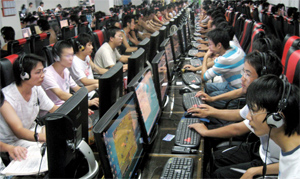 |
A Chinese Cyber Cafe - The Seats Look Quite Comfortable, Maybe Too Much So |
Cyber cafes, thousands of which have popped up all across China, have provided the playgrounds. A recent documentary by two Israeli film makers quoted one Chinese youth, excited about his performance, as spending three uninterrupted days at a cyber cafe playing games. Games account for almost 50% of activity at a Chinese cyber cafe. The documentary quoted one such player as saying: "It felt good."
Says a therapist at one of the IA Camps: “They think taking a restroom break will affect their performance at these games,” a program administrator said. “So they wear a diaper. That’s why we call it electronic heroin (my emphasis).”
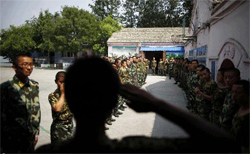 |
Chinese IA Boot Camp |
As mentioned above, Chinese parents send their IA kids to Internet Addiction Boot Camps. Says one professor: “I think China and especially Chinese parents take education very seriously,” “They saw a lot of teenagers, especially young male students, start to lose interest in school and devote much of their time to Internet gaming. They look to the camps as a kind of last resort for reforming their children... and then return them to school and become more academically capable.”
 |
Sensory Treatment |
At the IA Boot Camps the training is military-like and can be harsh -- there have even been reports of serious abuse up to and including death. Typically, kids can spend three to four months at a camp and their program may include "electronic sensory treatment". It's too early to have concrete findings of how successful these camps are or what the recidivism rate might be.
In the meantime, it's 更多,會發現 (more to be revealed).
Heavy-Handed Police - Again
Back in July of 2009, when GG had been living here only 10 months, we had an experience at the beach that I wrote up in ar article called Beach Attack. Up until that point there had been a large number of vendors on both sides of the side road that accesses the Mary y Sombra area on the north end of the main beach. There were also a number of vendors that were eliminated down near the oval turnabout near the park.
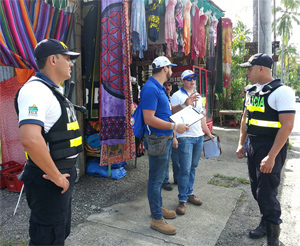 |
La Policia Evicting the Latest Group of Vendors from the Mar y Sombra Area |
 |
Equipment Used to Destroy the Stalls |
Without warning, one day in July 2009 dozens of several types of police and ministry officials descended on the local market and evicted a couple of dozen vendors, They moved others down to the alley near the national park entrance; these they eliminated in the latest raid. Curiously, at that time they left a dozen or so still at the Mar y Sombra, at least until last Friday:
In this latest round, the invading force consisted of the Fuerza Publica (national police), Policía Turística, Policía Transito (Transit Police - not sure what these folks do that Turistica doesn't), the Unidad Canine (K-9 Unit out of San José), local cops from the Municipalidad de Aguirre (Quepos), and even the Guardacostas (Coast Guard). In addition, they were accompanied by the Judicial Investigating Organization (OIJ - the Costa Rican equivalent of the FBI) and the Ministerio de Salud (Ministry of Health). Our reporter is not sure if the Department of Youth and Culture was also involved. The forces gave time to the 15 or so vendors at Mar y Sombra to extract their goods throughout the day and, either at the end of the day or early the next, they plowed under the stalls.
Call them a flea market if you will, but these arts and crafts purveyors have always been very popular with visitors and are a real part of local culture. These heavy-handed authorities gave no warning and made no attempt to reconcile the health permit and tax problems they used as an excuse to shut them down. Wouldn't it have been better to work out the permit and tax problems with the vendors by visiting them with a tax ministry rep and an OIJ dude as backup to persuade them to get with the system and show payment of taxes and a valid permit? They’ve had five years since the last raid to do so. One has to believe they're not really interested in correcting the tax and permit problems
The point about having a sanitary permit is a red herring; do they really believe a 9’ x 12’ booth should provide a bathroom for its customers? For that matter, where are the public bathrooms supplied by the local and federal government along a one-mile-plus beach for anyone to use? Non-existent, amigo. I suspect you could construct at least one baño unit for the cost of running the small army of police and authorities up to Manuel Antonio from San José to conduct the raid and harass the vendors.
One suspects the restaurants and merchants along the main beach to be behind this, complaining enough to the unknowing politicos in San José until they launch a police operation. I guess we should be grateful that we had five years between attacks and at least had peace for that long. The irony is that these vendors are largely arts and craft people not in direct competition to the “permanent” establishments in the center. We also lost the few remaining walking beach vendors that plied such threatening products as fresh coconut water and ceviche to beach bums like GG.
As a guest resident here for six years, I am still surprised that an essentially gentled-souled people like the Ticos can sometime act in draconian ways like this. We are losing an important part of our local culture here just to satisfy the politicos and opportunists. It’s sad to watch.
¡Poorer Vida!
Ceviche Festival Coming to Quepos
One of the vendors shut down in the latest police invasion was a friend GG has known for six years. I called her the ceviche lady and wrote about her in an article called Life's a Beach in April of 2012. She always made the point that what she offered was Ceviche Peruana or Peruvian ceviche which is interesting because that's the country that most people credit for the first such recipe. She gave me her recipe: cut uncooked firm whitefish into small pieces about the size of a ten colone coin, add the juice of limes (in Costa Rica we can also use limone mandarinas), thinly sliced red onions, some chopped cilantro, salt and pepper to taste and, her secret, top it off with a little Fresca to give it some zip. The fish "cooks" in the acidic mixture. Yummers. But one has to believe there are many versions of this delightful snack.
 |
The Chronicles has also noted several times the penchant for Costa Ricans to have festivals. So now, the newest of them in this area will be the Festival Gastronómico y del Ceviche to be held in Quepos this month on November 15/16 at the Marina Pez Vela. Various combinations of ceviche with seafood like that shown in the photo above will be offered.
Oh shucks, I forgot, I'll be in Buenos Aries on those days. No bueno. OK, guys, you'll have to hold up my part!
Enjoy!
Rumble Talk
(Shaky Happenings On or About the Pacific Rim)
Tropical Bird
of the Month |
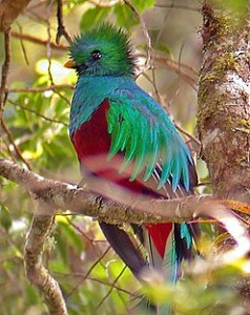 |
The Quetzel |
The Pacific Rim continued to be quite active over the past few weeks.
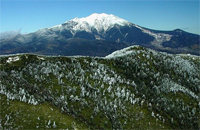 |
Mount Ontake - During a Calm Period |
One of more popular mountains for hikers in Japan is Mount Ontake on the island of Honshu. There were several hundred hikers on the mountain when the top blew on September 27 in a phreatic eruption (that's the kind where large amounts of water, like in a lake, come in instantaneous contact with magma that may be as hot as 1,100 ºC or 2,100 ºF) causing a steam explosion.
As the next few days passed, the death toll continued to mount and had reached 47 by October 1. This makes it the first fatal eruption in Japan in the last 24 years and the second most fatal in modern Japanese history after Torishima in 1902 when 150 died.
Meanwhile, in Peru on the same day, September 27, eight people lost their lives in an earthquake with an epicenter about 500 km (300 miles) northwest of La Paz near Cruzco. By the numbers, this one would be viewed as "moderate" as it was a magnitude of 4.9 on the Richter scale at a moderate depth of 43 km (~25 miles), about the same depth as the 2012 Nicoya tremor (7.6R) that irreparably damaged the Puntarenas hospital but didn't kill anyone. The difference in this case lies in the type of construction in the Cruzco area which is largely adobe. Most of the people killed were in their own homes as walls collapsed.
As October progressed the activity got closer to home. On October 13 GG was writing something about the new ceviche festival mentioned above when his apartment started to shake with a pretty good roll, not as much as some in the past, but pretty close. It lasted approximately 20 seconds (moderate time) but was only 28 km off the coast of Quepos and only 13 km deep (shallow as these things go) so the effect locally belied the Richter level of 4.5.
The Quepos tremor was at 9:31 and was followed exactly 20 minutes later at 9:51 PM by a second shaking not quite as bad as the first. The info from the U.S. Geological Survey put the second tremor at 7.3, some 67 km off the northwestern coast of Nicaragua near the El Salvador border (!) at a depth of 40 km. That strong earthquake produced significant damage in San Miguel, El Salvador, one reported fatality, and was felt all the way down the Costa Rican Pacific coast.
¡Pu...ur...a Vi...da!
| Check Out Recent Earthquakes Around the World Posted by the U.S. Geodetic Survey: Today's Quakes |
|---|
A Brief History of Argentina
(Part 2 - The Columbian Period 1500 to 1816)
A pending trip to Argentina this month prompted GG to research the history of the country and its capital Buenos Aires. (To see Part 1 - The Pre-Columbian Period, Prior to 1500, go here: Part 1)
 |
Amerigo Vespucci - Mr. America |
In the decade following Christopher Columbus' discovery and subsequent investigation of a large part of the Caribbean (included discovering Costa Rica - see History of Costa Rica - Part II), explorers from other countries became interested in the "new world". As we shall see, with regard to Argentina, the Columbian Period is not so much a tale of Spanish conquest as it is of European adventurism.
 |
Voyages of Amerigo Vespucci |
By the end of the Columbus decade these adventurers also began to deviate from Columbus' approach. Chris used the trade winds from Africa to go west and reach the Caribbean but new explorers began pursuing different routes to the new world. That brought Amerigo Vespucci, another Italian mariner like Columbus, along a more southerly route to the new world. Instead of finding the Caribbean Islands, he encountered South America, what is now Brazil to be more precise. Between 1501 and 1504 Vespucci made two voyages where he mapped a good deal of the southern part of the new continent, including parts that would become Argentina.
Returning to Europe in 1506, Vespucci presented his maps and claimed the southern part of the continent for himself but, like Columbus, he overreached and was never given that right. Amerigo had to settle eventually for the new continent being named after him, North and South America. He passed near the Rio de la Plata and made notes of its position but did not sail up the estuary or land there. The new, southerly routes also allowed more direct exploration of South America, from Brazil on down to what is now Tierra del Fuego and its many islands at the tip of the continent, today partially owned by Argentina along with Chile.
 |
Juan Diaz de Solis Discovered Rio de la Plata |
The person who would claim the honor of discovering the Rio de la Plata for the Europeans was Juan Díaz de Solís, a dashing rogue of questionable heritage (see picture left). Some said he was Portuguese and he evidently was in the Portuguese navy at one point (listed as João Dias de Solis), others say he was Spanish from Seville. Whatever his lineage, young Juan/João distinguished himself in early expeditions to South America (1506) and was later commissioned a Pilot-Major in the Spanish Navy. After that he was funded by the Spanish court for his own expedition in 1514.
In 1516, Solis reached and sailed up the Rio de la Plata. He called it Mar Dulce or "Fresh Sea" and waded ashore (to this day the estuary fills with silt easily and requires constant dredging). That was along the banks of what is now near Colonia, Uruguay directly east of and on the opposite side of the Rio de la Plata from Buenos Aires. Here's what one encyclopedia describes as to what happened: "...he landed on the east bank (modern Uruguay) and was attacked by the Charrua Indians of the region. He and the rest of the landing party, except for one man, Francisco del Puerto, were killed and eaten in sight of the remaining crewmen on shipboard." (My emphasis.). Puerto was made prisoner and later gave valuable information about the area to Sebastian Cabot, who arrived there in 1526." Kinda takes the romance out of exploration, doesn't it?
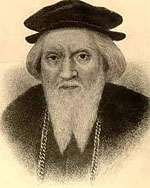 |
Sebastian Cabot |
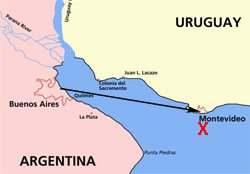 |
Rio de la Plata Estuary Looking North |
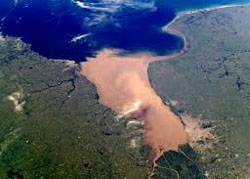 |
Areal View of Rio de la Plata from the North, Buenos Aires is at Right |
The area would continue to be a curiosity for the next twenty years. The Portuguese navigator Ferdinand Magellan briefly explored the estuary in 1520 before his expedition continued its circumnavigation of the globe. In 1526, another Italian, Sebastian Cabot of Venice sailed into the Rio de la Plata and set up a fortification near the mouth of the Paraná River which, along with the Uruguay River, feeds the estuary.
Cabot would also rescue Francisco del Puerto, the last survivor of the Solis barbecue of 1516 and from whom Cabot would hear the myths of great quantities of silver in the estuary area and up the two rivers. While huge amounts of silver (and gold) were later found in Peru, Bolivia, Chile and Mexico, it was never found in quantity in Argentina, but these stories had an influence in the the naming of both the Rio de la Plata and Argentina (see What's-In-a-Word section below).
The local natives, the "Indians" as the Europeans called them, in the spirit of Columbus, were no more friendly in Cabot's time than they were for Solis. Cabot had more firepower and would prevail but a short time after he left, the indians burned the encampment to the ground. Cabot was allied to several courts in Europe by relations and marriage, including England, and died in London in 1557 of an unspecified cause.
On February 2, 1536, the man who would historically get credit for founding the first settlement at the current site of Buenos Aires arrived. Don Pedro de Mendoza, a highly-favored Spanish nobleman, well fortified with troops and armament set up a settlement which he called Nuestra Señora del Buen Ayre (Our Lady of Good Air). This was another encampment that the Spanish abandoned and within a few years, the indians destroyed it. The settlement at Buenos Aires would not be re-established, permanently, until 1580. Mendoza attempted to return to Spain in 1537 but died on route, purportedly from a bad case of syphilis.
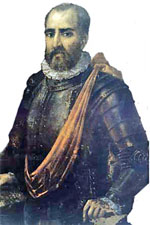 |
Juan de Garay |
For a long time the natives were not happy with the frequent visits of their uninvited guests. One historical wag said that the Spanish did not so much as conquer the Rio de la Plata area as they did settle it. Remember that these indians were the people (the Diaguitas for example) that stopped the expansionist Incas from Peru from overrunning the future Argentina. Finally, on June 11, 1580 a permanent settlement at Buenos Aires would be re-established under the direction of another Spaniard.
Juan de Garay was a Spanish nobleman and conquistador from the town of Junta de Villalba de Losa in Castile. He was politically connected to both the Spanish court and the Viceroyalty of Peru (for whom he worked). He founded several towns along the Paraná river and served as Governor of the Province of Asunción, which is present day Uruguay.
Juan didn't fare any better than his predecessors however. Here's how Wikipedia reported it: "... he died near the Río de la Plata, while traveling from Buenos Aires to Santa Fe on March 20, 1583, his group of 40 men, a Franciscan priest and a few women entered an unknown lagoon and decided to spend the night on the banks of the Carcarañá River, near the ancient Sancti Spíritus Fort (built by Sebastian Cabot - Ed.). The group was ambushed by Querandíes natives who killed Garay, the priest, a woman, and twelve of the soldiers."
GG hopes getting around in Argentina is more forgiving today than it was during the early colonial period.
During the 16th century, Spanish and other European explorers fanned out over much of the Americas looking for riches. They found plenty in Mexico and Peru in gold and silver as the indigenous peoples were already mining precious metals. The wealth of the Aztecs and Incas would be plundered. Whatever newly introduced European disease (malaria, measles, smallpox) didn't kill the Indians -- over 90% would eventually succumb - the rest were brutally subjugated by the Spanish conquistadors and their armies.
 |
By 1521, the Aztecs had been conquered by Cortez and his successors. Also, Mexico with all its gold became part of the Spanish Empire. Pizzaro arrived in Peru in 1533 and subdued the Incas. The wealth sent back to Spain from both countries was enormous; wealth the Spanish Court needed to finance its many adventures. There are written reports that in just one instance, when Columbus was anchored in Jamaica, a fleet of 17 treasure-laden ships left that port and ran into a hurricane, losing all but one of them. That was just one of the many, many fleets of "bullion" ships that left the Americas for Europe during the colonial period. Most of these goodies went to Spain.
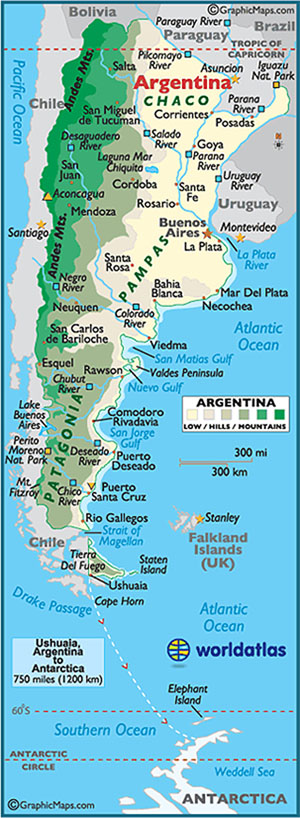 |
The importance to Spain of Mexico and Peru caused the Spanish court to set up Viceroyalties in both countries (Mexico City and Lima). The areas earlier dominated by the Aztecs and the Incas were the ones containing the vast treasure of the Americas but Argentina, like Costa Rica, had a relative lack of these riches. That put them in second place in the minds of the conquistadors and the Spanish Royals. Both countries may have benefited from benign neglect on the part of the Spanish as a result of their lack of gold and silver.
What kept the interest of the Spanish in controlling Argentina was the growing importance of the Rio de la Plata estuary for shipping and commerce. During the 17th century and into the eighteenth, Buenos Aires and other cities around the Rio de la Plata estuary slowly prospered in trade with each other, with northern Argentine cities, and with North America and Europe.
Although no new expeditions were sent from Spain during this period, colonization continued as Spanish expeditions from Alto Peru (Bolivia), Peru and Chile periodically forged south from the Andes. It was during this period that cities along Argentina's main rivers were founded including Santiago del Estero, Tucumán, Córdoba, Salta, La Rioja, San Salvador de Jujuy, San Juan, Mendoza, and San Luis. Besides these, Asunción, Santa Fe and Rosario also grew into prominence.
By 1776, the year of the U.S. declaration of independence from England, the area had become important enough to the crown in Spain that a new Viceroyalty was set up called the Viceroyalty of Rio de la Plata with its seat in Buenos Aires but which included Argentina, Bolivia, Paraguay and Uruguay. This was done also to strengthen and fortify a Spanish area that was receiving renewed interest on the part of the British and Portuguese as they saw their empires crumbling.
The early 1800's would prove tumultuous times in Argentina as they were in many parts of the new world. The success of the U.S. war of independence against England stirred similar feelings all over the Americas while the old empire structure tried to retain its holdings and looked to replace some of their losses with new territory. In 1806 and 1807, the British made a series of unsuccessful attempts to seize control of the Spanish colonies located around the La Plata Basin in both Argentina and Uruguay. They had only temporary successes, even invading Buenos Aires for a few days, but eventually they were repulsed and took heavy losses.
By 1810, revolutionary fervor hit a peak and was backed by a strong commercial bourgeoisie. A revolutionary movement was created called the Provincias Unidas del Río de la Plata (United Provinces of Río de la Plata). On 25 May 1810, the cabildo (town council) of Buenos Aires deposed the Spanish viceroy. But ties were not completely broken with Europe as the leader then announced that the new government would govern henceforth on behalf of King Fernando VII, then a captive of Napoleon. Like in the U.S., royalist sympathies died hard.
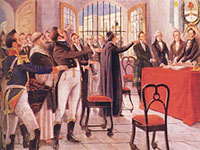 |
Argentine Independence Day in Tucumán |
By 1816 many of the powerful and influential Argentines were ready for true independence. Representatives of the various provinces convened in the northwest city of San Miguel de Tucumán in March 1816. By July 9 the delegates were ready and proclaimed independence from Spanish rule, declaring the formation of the United Provinces of South America (essentially retitling the United Provinces of the Río de la Plata).
The delegates also elected a so-called supreme director to head the new state but the congress was unable to reach agreement on a form of government. Delegates from the Buenos Aires provincial region favored the creation of a constitutional monarchy. This position, which was later modified in favor of a highly centralized republican system, met vigorous opposition from the delegates of the other provinces, who favored a federal system of government.
Friction between the two factions (federalists and unitarianists) mounted steadily and resulted in a civil war in 1819. Conflict would rage and sputter until 1880, at times involving Uruguay, the British and the French. This would not be a country of easy evolution of politics but instead one of continuing difficulty all the way up to modern times.
More on that next month in Part 3, The Argentine Modern Era.
¡Solo Bueno!
White Water Rafting Without a Raft
(A Personal Corcovado Adventure)
GG had the pleasure of joining a group of gents from San José, some 18 in total, on a four day trip into the Corcovado in mid-September this year.
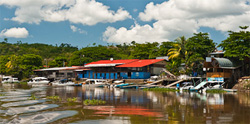 |
Main Dock in Sierpe |
On Friday, September 12, a buddy and I drove down to Sierpe, a small river town about 1-1/2 hours by car south of Quepos. The river is the Rio Sierpe, named after the town which is smaller by half than Quepos. It was apparent by quick observation that much of the town's commerce depends on the tourist trade. After some time we boarded two launches with large outboard motors and began our run down stream to the sea at a clip which GG estimated to be around 20-25 miles per hour. The restaurant where we boarded was named Oleaje Serena or "serene waves". We were to test that name.
 |
A Bend in the Rio Sierpe |
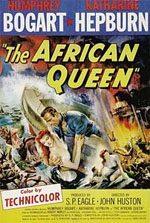 We motored serenely for about a half hour encountering very few waves, weaving around flotsam such as tree limbs washed into the stream during heavy rains and gently around the tranquil bends in the river. The jungle was dense with many mangroves along the banks and various types of trees reaching up to impressive heights in the sky. I felt a little like Humphrey Bogart in African Queen (United Artists, 1951, Directed by John Huston, starring Humphrey Bogart and Katherine Hepburn).
We motored serenely for about a half hour encountering very few waves, weaving around flotsam such as tree limbs washed into the stream during heavy rains and gently around the tranquil bends in the river. The jungle was dense with many mangroves along the banks and various types of trees reaching up to impressive heights in the sky. I felt a little like Humphrey Bogart in African Queen (United Artists, 1951, Directed by John Huston, starring Humphrey Bogart and Katherine Hepburn).
My buddy, who happens to be a guide himself in the Quepos/Damas area, corrected me when I pointed towards large, blackish bulbous growths on some of the trees and suggested they were termite nests. "No, amigo, those are salt deposits from the white mangrove trees - it's their way of dealing with the excess salt they consume in these brackish waters". Oh yeah, now I remember that particular fact from one of his tours I had taken a few years ago.
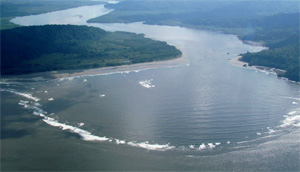 |
Boca Sierpe - The Mouth of the River |
After a half hour of traveling, the river widened substantially and in the distance one could see the breakwater at the mouth of the river where it emptied into the Pacific. GG began to get a little nervous, remembering a similar type of rip current in Massachusetts where he grew up. That one involved the Merrimac River where it emptied into the Atlantic. As a teenager, he had gotten caught in the rip tide once in a 14 foot skiff with a 20 hp outboard and was nearly swamped; he'd been nervous at scenes like this ever since.
As we got closer, the waves got bigger and were obviously of a size (five to eight feet) that could easily swamp even our larger boat. Heading directly towards a big wave, the captain suddenly veered to the left and headed into the wake of a wave that had already crashed and was diminishing itself against the opposing current caused by the river. Outstanding piloting thought GG. In this way, our captain bobbed and weaved through the turbulence emerging about five minutes later on calmer ocean. Another 20-25 minutes brought us to our camp near the south-central part of Bahia Drake or Drake Bay (yes, Dorothy, the place is named after that infamous English privateer Sir Francis Drake who purportedly dropped anchor there sometime during his 1578-9 global circumnavigation).
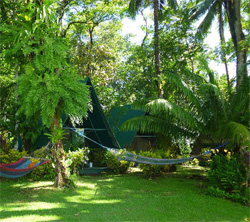 |
Corcovado Adventures Tent Camp It's a Jungle Out There |
At our destination, the captain backed the boat up to a beach at just the right moment between sets of waves. We hopped off - no dock here amigos. The camp (www.corcovado.com) has been around for many years and is accessible only by beach or long walk through the jungle from the nearest town -- no roads here either. We were assigned a tent with raised wooden floor -- actually we grabbed one and management acceded to our choice. We were less than fifty feet from the ocean crashing against a large volcanic rock outcrop -- that sound would become soothing and almost hypnotic over the weekend.
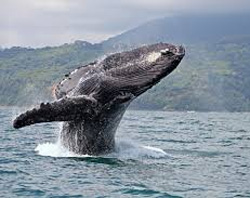 |
Adult Whale Breaching the Surface |
We had arrived a little after noon, had a lunch at 1 PM and sent the afternoon as each person saw fit. On Saturday, breakfast was at 6:30 AM and afterwards we re-boarded the launch we had used the previous day and went ballena (by-yeah-na = whale) watching. September is mating season and this part of Costa Rica is one of the areas where they gather to do the deed. Over a four hour period, we saw a bunch (30?) of ballenas rolling by, some breaching the surface particularly the younger and more playful ones. We also had a couple of episodes of watching playful dolphins running along side the boat.
On Sunday, the tour organizer offered us a choice of more whale and dolphin watching and swimming at a remote beach or we could take a hike on our own recognizance through the jungle along the coast. Several of us chose the latter. It's difficult to estimate the distance we hiked because the terrain is so rough but perhaps it was two miles in one direction and it took us an hour and fifteen minutes. The trail consisted of very difficult walking paths designed to trick the Golden Gringo into tripping, but I didn’t, relying on my Quepos walking hazard training. We reached the Rio Claro river (that day it actually was quite clear) and we needed to cross the mouth on foot to get to the only refreshment stand we had seen anywhere along the trail.
 |
Boca Rio Claro |
The boca or mouth of the river was a shallow rapids as the tide had just turned and the large tide pools (the locals call them swimming holes) in the forest above the mouth began to drain furiously. The average depth seemed to be just above the knees and I followed the younger dudes as they waded across the mouth. But I didn’t expect the shifting sands on the bottom of the stream that made balance a serious question for us old geezers, and I fell. Into the drink GG went along with his waist bag or fanny pack that contained his cell phone and wallet. GG's watch. of course, was also not waterproof.
My buddy from Quepos and another dude, a really nice dentist named Eric from San José (strong and young at age 42), grabbed me and, with difficulty, righted me and then helped me the rest of the way across. When I fell, I began sliding downstream from the force of the rapids and I saw that I was headed to the point (only about 25 yards away) at which the river went into the sea. The resulting turbulence where the two waters met was rather scary looking from my prone position. I figured if I ended up hitting that, I’d wash ashore somewhere in Panama later. It felt like I was white water rafting without the raft.
Later, Eric the dentist mentioned that his dad was my age (one year older) and had asked him once how he was feeling. Dad responded that his balance was not what it used to be and that “mature” people of 70+ were often physically in a state of “free fall”. “Yes!” says I. Eric watched over me for the rest of the weekend, guiding me across the mouth later when the flow had dropped and watching over me on our return boat trip on Monday where he carried my very heavy backpack filled with wet clothes and water soaked sneakers. Those sneakers seemed to weigh 20 lbs by themselves and the total pack on the order of 40 lbs. Once clothes were damp from the day’s activities, they never got dry again as the area gets the typical afternoon and evening rains like Quepos-Manuel Antonio. Stuff wet on Friday was still wet on Monday morning. Nothing but nothing dries in that atmosphere.
 |
On Monday morning after breakfast we re-boarded the boat, this time during high tide making it even more interesting for the captain to negotiate the waves at the beach. The confusion of people trying to get aboard and the anxiety of the captain to get away from those (8 foot?) waves caused one dude to be left on the beach. He was subsequently sent out to meet us via kayak, piloted by a camp assistant, as we hovered about 30 yards out beyond the breakers. I sensed the captain's great hesitancy to risk backing in again and I silently agreed.
The high tide caused the waves at Boca Sierpe to be even bigger (10-12 feet?) than when we arrived on Friday. Our camp host suggested (nay, ordered) that we put on our life jackets. At one point a fellow passenger and I looked back to see a large wave heading for us; we then looked at each other uneasily and we both just turned forward hoping for the best. The captain managed to do his weaving and bobbing act successfully once more and within a few minutes we were once more through the dangerous part and serenely motoring up the river to Sierpe village.
When people talk about wild Costa Rica they mean places like the Corcovado. It is one of the most dramatically beautiful wildernesses still available in this hemisphere. But be cautious; if you don't have the agility to negotiate the boat experience and the terrain, it might be best to think twice before plunging (literally) into this area. The water in Corcovado, both ocean and river, deserve careful respect.
¡Pura Vida!
Travel Quote of The Month |
“Without new experiences, something inside of us sleeps. |
Holy Crocodile!
(How Some Costa Ricans Get Their Exercise)
A friend of GG's, Jack Donnelly, lives in Heredia and has authored a book on Costa Rica called Costa Rica: Folk Culture, Traditions, and Cuisine (link below). Among the various stories in this book about Tico folk culture was one about an unusual festival having to do with our cocodrilos (crocs). Jack has agreed to share the story from his book with us:
HOLY CROCODILE!
One of the stranger folk traditions in Costa Rica is practiced in the Guanacaste town of Ortega de Santa Cruz. In this remote village in the northwestern part of the country, there is a group of men called the Lagarteros de Ortega or Lizard Men of Ortega. On Good Friday (Holy Friday), they jump into the crocodile infested Tempisque River, armed with only sticks and ropes to capture the largest “lizard” they can find. This has been their tradition for hundreds of years.
 |
Come On In, the Water's Fine |
The trailhead is a few miles outside of town and is the scene of a festive Good Friday party. There is music, food, a few professional photographers, maybe even a TV video crew, and a lot of people waiting anxiously for the reptilian nightmare to make its appearance. The Ley Seca, a ban on alcohol sales for Holy Thursday and Good Friday, is openly ignored. (recently the federal government has made it optional for each Canton to decide whether or not to sell alcohol during this period - GG)
Many people will hike, ride ATVs, or drive 4 x 4s a mile or so to the river in hopes of seeing the actual capture. They are all carrying heavy coolers, and it’s not a very good trail. In fact, the lagateros will not settle for just any wimpy little croc; they want a big one. To accomplish this, they will search until they find a toothy beast worthy of the honor. This may or may not be in sight of the eager onlookers. Either way, the captured critter is carried on their shoulders to a waiting truck at the trailhead and escorted into town by hundreds of spectators.
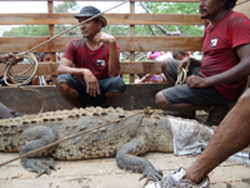 |
The Lizard Men at Work |
The hapless croc spends the day as the unenthusiastic guest of honor at the town festival. It is released the following day. Some stories relate that originally the guest was killed on Easter Sunday and its fat used for making curative potions. This minor witchcraft is no longer practiced, but the people of Ortega are fiercely proud of their tradition.
In my experience, the locals can get a little short when asked about the meaning of this tradition. I’m not sure if they are just tired of the question, or if they feel visitors suspect them of something pagan or primitive. They get a determined look on their faces and resolutely state, “It’s just our tradition.” (Copyright © Jack Donnelly 2014)
 |
Muchas gracias to Jack for sharing this story with us. Here's the Amazon.com link to Jack's book: Costa Rica: Folk Culture, Traditions, and Cuisine.
And here are some additional articles from previous issues of the Chronicles about our big lizard friends:
Crocodiles, Love Those Crocs: Edition 34 - Man's Best Friend
Crocodiles, Reptile Shenanigans: Edition 60 - What a Croc This Is
Crocodiles, How Not to Feed Them: Edition 70 -Swimming Anyone?
In Costa Rica, it's always good to check out where you're going to go swimming before taking the plunge!
¡Pura Vida!
What's-in-a-Word
Argentina
The name of Argentina is a Spanish adjective meaning "silvery"). It was traditionally called the Argentine in English, coming from the Latin argentum or "silver". The first use of the name Argentina can be traced back to the early voyages in the first half of the 16th century made by the Spanish and Portuguese conquistadors to the Río de la Plata area including modern Uruguay.
Rio de la Plata
The English name "River Plate" is not, as sometimes thought, a mistranslation, as "plate" was used extensively as a noun for "silver" or "gold" from the 12th century onwards, especially in early modern English. The estuary has been known as the River Plate or Plate River in English since at least the time of Sir Francis Drake and his worldly circumnavigations in the second half of the 16th century.
A modern and better translation of the Spanish Río de la Plata is "Silver River", referring not to color but to the riches of the fabled Sierra de la Plata thought to lie upstream (never found). The English version of the name served as an inspiration for one of Argentina's most important football clubs, Club Atlético River Plate (still didn't get them the world cup this year though).
ROMEO Corner
(Retired Old Men Eating Out)
Fred's Place, Manuel Antonio
Had this place not been called out by one of our ROMEOs who has lived here for 40 years, it may have continued to go unnoticed by GG and many others. It's tucked away in the northwest corner of the Hotel Mariposa property and not easily seen from the road.
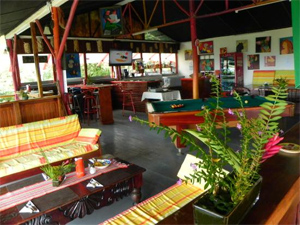 |
Upstairs Dining Room at Fred's Place |
Location: Top of Manuel Antonio hill on the grounds of the Hotel Mariposa (side road to Arenas del mar).
Hours: Breakfast (?), Lunch and Dinner
Parking: Adequate, on site.
Contact: Tel.: 506 2777 6858; Email: N/A; Website: N/A
Reviewing ROMEOS: Alma L., Anita M., Lance M., Mary M., Tom R., Bob N.
To Review Our Rating System and Procedure, go here: R.O.M.E.O. Rating System
We were greeted by Fred himself, who took us up to the second floor, via a spiral staircase to the second floor where the main dining room is situated facing the Pacific Ocean (as with all M.A. restaurants, if you want to see that view in all its glory, it's lunch for you or get there early for dinner - we arrived at 6 PM in the dark). This is the very slow off-season and only one other couple joined the restaurant while we were there.
Fred is of French extraction, having grown up in St. Martin and lived in several countries around the world including the U.S. before landing in Costa Rica (worldification is not an uncommon story in these parts). Fred not only greeted us, he seated us, menu-ed us, took our orders, served us drinks, cooked our orders and billed us. What great fun to have one person to deal with for all that service!
The atmosphere at Fred's Place was described by the ROMEOs as "eclectic" or "camp" (see photo above). Basically it's the kind of comfortable, informal look that fits well into an open air restaurant in the rainforest. Much of the art work on the walls was painted by Fred. We sat at a large, tile-inlaid table, half booth, half seats, with cushions for GG's bad back (thanks Fred). Four sloths for atmosphere.
The menu was not extensive but offered enough variety to please most palates. There were a number of entradas but the group this evening went directly for main courses and selected fish, shrimp and tenderloin dishes. Comments rising from the table were very favorable for all dishes. My tenderloin was surprisingly tender, especially when Fred told me it was Costa Rican beef (beefy things are slowly getting better in Ticoland, yeh!). There was a distinct garlic accent on both the shrimp dish and the tenderloin, which had a light slathering of a garlic sauce, that seemed to me to reflect Fred's Gallic heritage (typical of French country cuisine). The only critique some of us had (guess who) was that the accompanying vegetables (plain rice, steamed veggies) were fresh and good but didn't rise to the level of creativity we were about to experience with desert. |
 |
|---|---|
$$$ 1/2 |
|
Value Index = 129 |
When it came to postre time, several of us quickly noticed an unusual offering; a combination chocolate and mango mouse tart or pie. What arrived was slice of a flaky pastry with a bottom layer of creamy chocolate mouse supporting an upper layer of creamy mango mouse (yes) and accompanied by a dollop of chantilly (whipped cream to the non-French). Outstanding. Four and a half sloths for food quality (half a sloth off perfect for the vegetables - don't ask which half).
Fred's service was attentive, polite and friendly. For atmosphere, food quality and service we give Fred's Place a 4.5 sloth rating overall.
The tabs ranged from a total of $22 to $26 (the latter was GG's tenderloin of course). $26 (or about 14,000 colones) for a tenderloin, mousse dessert, a soft drink and a coffee in Manuel Antonio is a bargain. We give Fred's Place a 3.5$ rating for cost and that results in a 4.5/3.5x100 = 129 value index, putting the restaurant in the top 20% of MA restaurants for value.
The ROMEO group can easily recommend Fred's Place for a pleasant dining experience, good food and a good buy.
don Beto de Quepos,
El Gringo Dorado Pura Vida! |
Be pithy but kind. I'm sensitive. |
|---|










